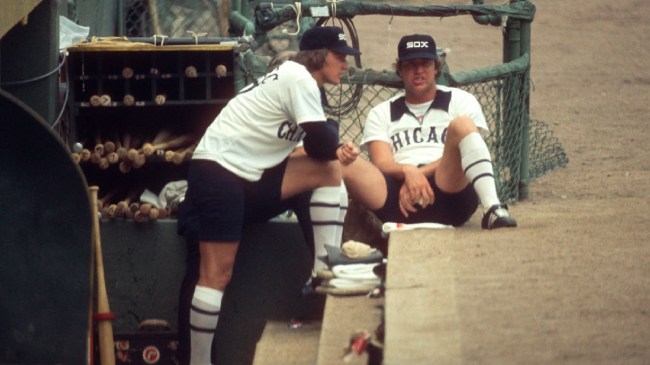
Getty Image
Sports leagues and teams around the world are constantly experimenting with different marketing strategies in the hopes of attracting more attention, fans, and, of course, the money that comes along with both, and the Chicago White Sox are no exception.
The nature of experimenting means you’re not going to hit it out of the park 100% of the time, as the whole point of trying out various approaches is figuring out what works and what doesn’t.
As a result, there are plenty of scenarios where a ton of time and effort was exerted to dream up a publicity stunt that was met with reactions ranging from “Fierce Backlash” to “Defeaning Indifference,” like the MLB’s ill-fated (and league-mandated) “Turn Ahead the Clock” promo in the late 1990s, which failed to make the kind of impression the people behind it were undoubtedly hoping for.
There’s arguably no figure in baseball history who came up with more schemes to attract attention to his team quite like Bill Veeck.
The man who owned franchises in Cleveland, St. Louis, and Chicago over the course of his career was a serial promoter who dreamed up “Disco Demolition Night,” the infamous debacle that forced the White Sox to forfeit a game against the Tigers thanks to the riot it spawned.
However, that wasn’t the only experiment that didn’t exactly pan out.
The time the Chicago White Sox uniform (briefly) included a pair of shorts

Getty Image
As I alluded to above, Veeck (who more than earned the nickname “Wild Bill”) was notorious for the many, many schemes he spawned to drive up attendance and revenue at the ballparks of the teams he oversaw, like:
- Hiring Max Patkin, a professional “baseball clown” who served as an official bench coach for Cleveland in the 1940s
- Burying the American League pennant the team then known as the “Indians” won in 1948 the following season after they failed to repeat
- A “Choose Your Own Adventure” game that allowed fans of the St. Louis Browns to vote on in-game strategy in the 1950s
- Signing Eddie Gaedel, who stood at 3’7″ (making him the shortest player in MLB history) and wore the number ⅛.
Veeck was particularly obsessed with jersey alterations; he loved messing around with the idea of “uniforms” and reasoned he could get away with basically anything as long as every player on the team was wearing the same thing.
Some of those innovations actually had a major impact that can be felt to this day. Veeck is widely credited with being the first person to display player names on the back of their jerseys, so while he may have been onto something there, it’s hard to say the same about the shorts the White Sox debuted in 1976.
The shorts (which Veeck dubbed “Hollywood Shorts”) were a concept the owner had dreamed up prior to the start of the season; he argued, “Players should not worry about their vanity but instead their comfort. It’s 95 degrees out and an athlete should be glad to put on shorts” (and to be honest, he kind of had a point).
The shorts (which were accompanied by socks with a rubber ring designed to prevent any scrapes or other friction-related injuries) were initially modeled in March of that year but made their official debut during the first game of a doubleheader between the White Sox and the Royals at Comiskey Park on August 8, 1976.
Kansas City first baseman John Mayberry couldn’t stop himself from having some fun at Chicago’s expense, as he reportedly said “You guys are the sweetest team we’ve seen yet!” and told White Sox outfielder Ralph Garr, “If you get over to first base, I’m going to give you a big kiss!” (he did not, in fact, make good on his offer when Garr got on).
The White Sox ended up winning the game 5-2, which didn’t really matter compared to the press the shorts were able to generate. Veeck lived by the motto “Any press is good press,” and he didn’t care if some of his players had to risk tearing up their kneecaps to generate it.
Veeck subsequently announced the shorts would make their grand return on August 21st for a game against the Orioles, and guess what? Attendance went way up and the Sox won in extras. Veeck’s idea was looking brilliant.
They decided to wear the shorts the following night as well, but their luck ran out. The Sox lost, the press lost interest, and attendance started to go down as the formerly magical piece of attire started to lose its luster.
At least it was fun while it lasted.